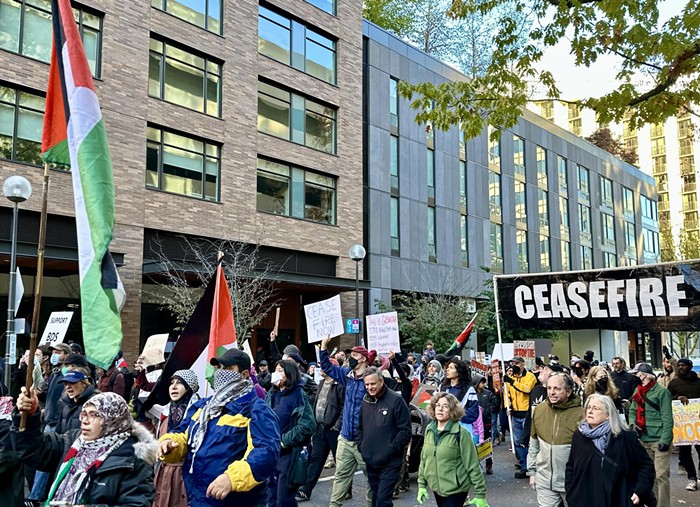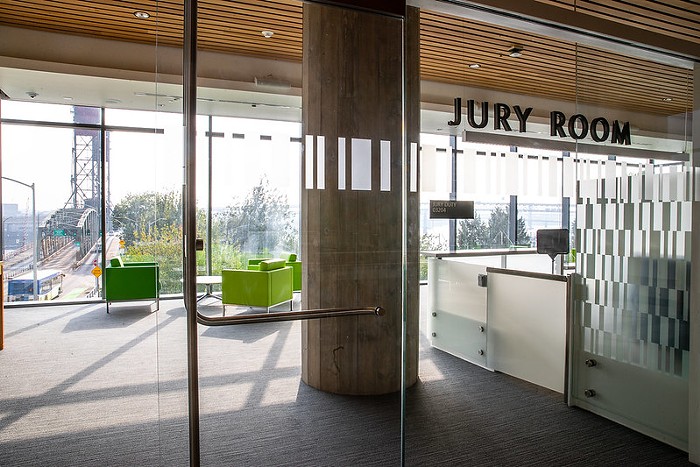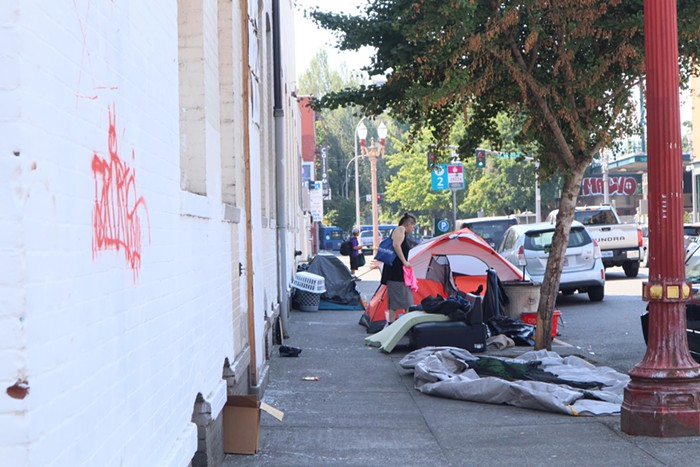
As the Oregon Department of Transportation (ODOT) moves forward with a plan to expand the Interstate 5 corridor towards Harriet Tubman Middle School, local officials, school representatives, and community members differ on whether the student body should be forced to move buildings to avoid the freeway’s pollutants.
Portland City Commissioner Jo Ann Hardesty spoke to a crowd of environmental activists Wednesday evening in front of Harriet Tubman in North Portland near the Rose Quarter. The crowd of approximately 40 people were there in support of Youth vs ODOT, an ongoing protest movement in opposition to ODOT’s freeway projects, led by environmental activists in Sunrise Movement PDX. ODOT’s planned widening of I-5 through the Rose Quarter to address traffic congestion is slated to bring the freeway within 25 feet of Harriet Tubman, raising concerns from the school district and local officials that the poor air quality surrounding the school will only be made worse by the project.
“Like you, I have a low level of trust for ODOT,” Hardesty told the crowd. “Like you, I’m drawing a line in the sand that says there are some conditions that must be met if this project moves forward.”
The crowd clapped in support.
“The fact that these students, whether they continue forward with this project or not, are continuing to breathe this air is inexcusable,” Hardesty continued. “So whether the project happens or not, the school must move. Do you agree with that?”
Grumbles of disagreement rolled through the group. It wasn’t the response Hardesty was expecting.
Moving Harriet Tubman students to a new building away from freeway pollution has been framed by local leaders and Portland Public Schools (PPS) board members as a possible step towards restorative justice. When the original I-5 corridor was built in the early 1960s it was built about 50 feet away from the school, exposing the student body to dangerous pollution levels. A 2018 study from Portland State University concluded that the air quality outside the school is so poor that students shouldn’t be allowed to play outside during high-traffic times. Albina—Portland’s historically Black neighborhood that feeds into Harriet Tubman—was partially razed to make way for the freeway, displacing hundreds of Black Portlanders.
In July 2021, the PPS board resolved that, if the I-5 Rose Quarter project moves forward, state leaders and ODOT must “accept the responsibility for the harm they have caused” to Harriet Tubman students and “secure the funds to rebuild Harriet Tubman Middle School in a safe, healthy location in Historic Albina.” While the board is requiring the school to move only if the I-5 Rose Quarter project continues, members of the school board have referred to moving Harriet Tubman to a new location—project or no project—as a way to “right some of those historical wrongs.”
According to Harriet Tubman teacher Bryan Chu, moving the student body from the school due to air quality issues is a “false narrative.” Chu, who has been teaching social studies at Tubman since it reopened in 2018, argues that the district has already mitigated the largest air quality concerns at Harriet Tubman.
In 2018, PPS spent about $18 million to upgrade Harriet Tubman’s air filtration system to combat air pollution. The filtration system filters out about 95 percent of pollutants in the air, delivering arguably the best indoor air in any PPS school. When it comes to concerns about outdoor air quality, Chu notes that many of the alternative school locations proposed by PPS staff are also near high-traffic areas.
Of the eight proposed relocation sites, half are flanked by one or more high-traffic streets. For example, PPS staff proposed moving Harriet Tubman students to the Blanchard Education Service Center (BESC), a district-owned building. The building is in a waterfront industrial zone that’s still near the freeway; moving Harriet Tubman students to BESC would put about 700 more feet of space between them and I-5.
“What would happen if they tested the [outdoor] air quality there, too?” Chu said, arguing that there isn’t any certainty the next location will be any better than Harriet Tubman’s existing location.
Anticipating the I-5 project to continue, the school board aims to relocate Harriet Tubman students to a new building by the 2027 school year and will determine the school’s new location by May 2022.
The future of the I-5 project was slightly challenged by the Federal Highway Administration in January. The administration decided that the design of the Rose Quarter project had changed significantly enough since its original approval to warrant a new environmental assessment, a study of how the project will impact the surrounding area. While ODOT believes the new assessment won’t interfere with breaking ground on the project in late 2023, environmental activists like Sunrise Movement PDX are hopeful the new environmental assessment will reveal that the project will have significant impact on the surrounding area. If that is the case, ODOT will have to perform an Environmental Impact Statement (EIS)—a rigorous environmental study of the project that will take years to complete, delaying the project. Environmental activists want an EIS because it could force ODOT to shift gears and instead rely on tolls to control congestion on the freeway as opposed to additional lanes that activists fear will bring more cars and carbon emissions to the area.
At Wednesday’s rally, Hardesty voiced her support for a more extensive EIS for the Rose Quarter project, earning a large cheer from the crowd.
“If Tubman wants to move, then they’ll move,” Hardesty told the Mercury after the rally. “If they don’t want to move, we shouldn’t make them.”



















